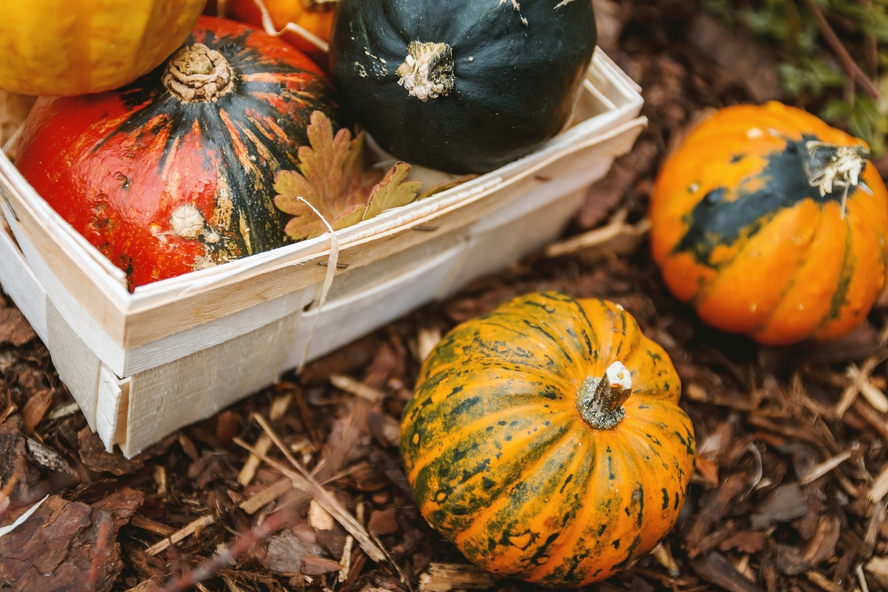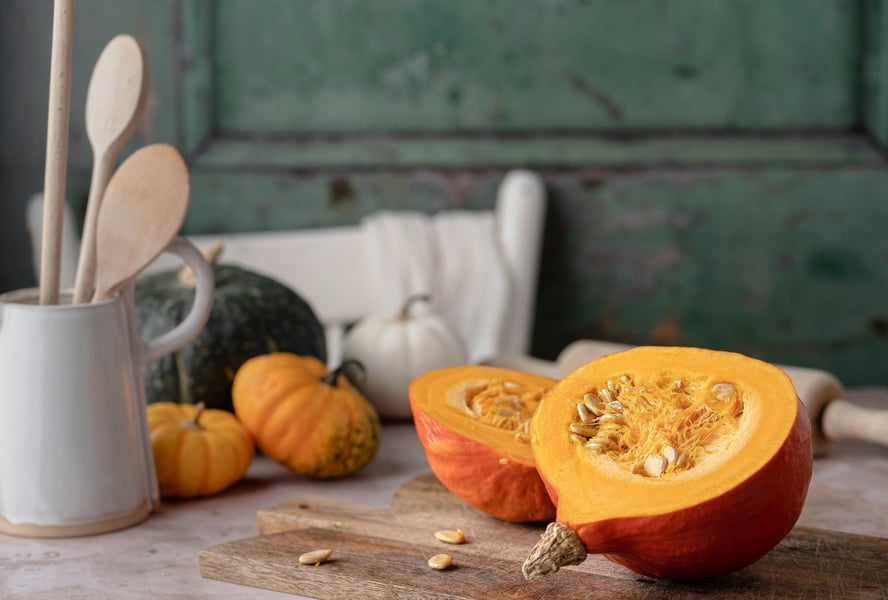Can You Eat Heirloom Pumpkins? Here’s Why They’re Better Than Regular Pumpkins
Can you eat heirloom pumpkins? Here’s everything you need to know to put your fall decorations to good work in delicious seasonal dishes.

Heirloom pumpkins look so cozy gracing a decorated Thanksgiving table, greeting visitors from the front porch, or sprinkled throughout the home for a touch of autumn flair and color. But when you’re ready to put the fall decor away, one question remains: can you eat heirloom pumpkins?
When it’s time to deck the halls with boughs of holly, don’t throw away those gorgeous pumpkin decorations. Eating heirloom pumpkins is a delicious and resourceful way to make the most of your pretty fall decor.
What Are Heirloom Pumpkins?
Heirloom pumpkins are varieties of pumpkins grown from seeds that have been passed down for generations. Heirloom pumpkin varieties are often handed down through families or small communities, rather than going through any large-scale production. They often have unique characteristics, whether that’s a distinct shape, color, size, or flavor.
The biggest differences between heirloom pumpkins and grocery store varieties are their thicker walls, which yield more flesh for cooking, and their sweeter taste, which is why varieties like Sugar Pie are popular for, well, pies.
Grant Butler, writer at The Oregonian
Are Heirloom Pumpkins Edible?
Yes, heirloom pumpkins are edible! In fact, many believe that heirloom pumpkins taste better than generic grocery store variety pumpkins. Whether you eat them roasted, pureed, or baked, heirloom pumpkins are delicious and definitely worth trying.
What Is the Difference Between Regular Pumpkins and Heirloom Pumpkins?
While it’s difficult to make a broad statement because there are so many different heirloom pumpkin varieties, they tend to have thicker walls and more pulp than your typical jack-o’-lantern variety (also known as the Connecticut field pumpkin). They usually have a sturdier texture, rather than the stringy pumpkin texture we might be used to scooping out on Halloween.

Finally, they have a slightly sweeter flavor that famously makes them a great choice for pies and other desserts! Unlike Halloween pumpkins, which tend to be bland and are best suited for carving faces, heirloom pumpkins offer taste and texture unlike any other squash.
“The biggest differences between heirloom pumpkins and grocery store varieties are their thicker walls, which yield more flesh for cooking, and their sweeter taste, which is why varieties like Sugar Pie are popular for, well, pies,” notes Grant Butler, writer at The Oregonian.
Types of Heirloom Pumpkins

Heirloom pumpkins, also known as specialty pumpkins, come in all shapes, sizes, and colors. From orange and green striped Kakai pumpkins to brilliant blue Jerrahdale pumpkins, white moonshine pumpkins, French Musquee de Provence pumpkins, and everything in between.
Eating Heirloom Pumpkins
Pumpkins are way more than just pie, of course.
Pumpkins are grown around the world and used as culinary staples in Indian, Thai, Mexican, and Scandinavian cuisines, among others. Heirloom pumpkins taste amazing when pureed, cut into pieces, grilled, fried, and so much more.

Like winter squash, heirloom pumpkins require a decent amount of time to cook — but their rich, nutty flavor makes it all worth it.
How to Cook Heirloom Pumpkins
Start by scooping out the pumpkin seeds and set aside if roasting. More on this later!
To cook an heirloom pumpkin, preheat the oven to 400 degrees Fahrenheit and line a baking tray with parchment paper.
Place the pumpkin cut side down on a parchment paper tray and roast for 30-60 minutes, depending on the variety and its size. You’ll know it’s done roasting when a fork can easily pierce the pumpkin.
Once roasted, carefully peel the skin from the pumpkin flesh and discard. These pieces of cooked pumpkin are now ready to eat. They can be added to hearty winter grain salads, tacos, and more — or you can simply eat them on their own as a side dish with salt, pepper, and olive oil.
If you don’t have time to roast your pumpkin, raw pumpkin can also be added to soups, stews, and curries to be cooked along with the broth. This is an easy way to add flavor and texture to delicious recipes.
How to Cook With a Whole Pumpkin

It can take a little muscle to cook an entire pumpkin due to its tough skin and hefty size. The next time you plan on roasting a whole pumpkin, use a sharp knife to carefully cut your pumpkin in half or into multiple smaller pieces.
If the pumpkin is too large or hardy and cutting it is not an option, hold it firmly and smash it against a hard surface, like concrete or bricks. From there, you can follow the same roasting steps above to enjoy delicious pumpkin dishes!
Can You Eat Heirloom Pumpkin Seeds?
Yes! Now that you’re cooking with your heirloom pumpkins, you may as well make the most of the whole thing. After you cut up your pumpkin, be sure to save the seeds — they make an easy, tasty, and nutritious snack.
Heirloom pumpkin seeds have all the health benefits of regular pumpkin seeds, and some even believe they’re larger and more flavorful. With so many ways to incorporate them into your diet, they’re absolutely worth saving to roast as a snack or even eat them raw.
How to Store Pumpkins
Heirloom pumpkins store very (very!) well, with some boasting storage life of up to six months. Stash pumpkins in a cold, dark space to use in recipes throughout the winter.
How to Make Pumpkin Puree
If you’re looking to utilize the flavor of the pumpkin without necessarily adding pieces of pumpkin to your dish, puree is the way to go. Pureed heirloom pumpkins are perfect for sweet recipes (like pie), creamy soups, and even smoothies. To make pumpkin puree, scoop out the cooked pumpkin flesh from its skin and add it to a food processor or high-speed blender. Process until the pumpkin is completely smooth and creamy.
Pumpkin puree can be frozen and stored for one year, so the fall is a perfect time to make a big batch that will last!
Recipes That Use Pumpkin Puree

Here’s a list of recipes that use pumpkin puree for some inspiration:
- Pumpkin Spiced Latte
- No-Bake Pumpkin Balls
- Homemade Pumpkin Pie Spice
- Pumpkin Chia Seed Pudding
- Pumpkin Muffins [Gluten Free and Vegan]
- Homemade Pumpkin Pie from Scratch!
- Pumpkin Oatmeal
- Spicy Roasted Pumpkin Soup Recipe with Leek
- Pumpkin Fettuccini Alfredo Pasta with Greens [Dairy-Free]
The Health Benefits of Pumpkins
The perks of eating pumpkins? Plenty of fiber, vitamins A and C, antioxidants, iron, potassium, copper, and protein in a delicious, versatile fruit (we know, it seems more like a veggie to us too).
Plus, pumpkin is low-calorie while still packing a nutritious punch. It’s also rich in antioxidants, which have been shown to help prevent chronic diseases and even lower the risk of cancer.1 So, the next time you have some pumpkin decor to throw away, think twice!
Read More on Organic Authority

Sources:

